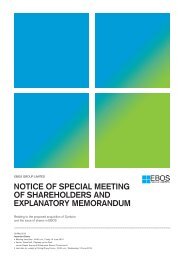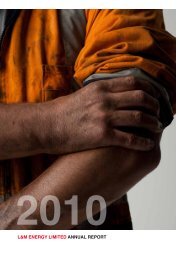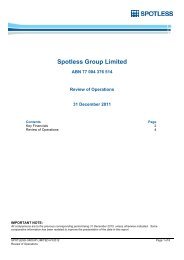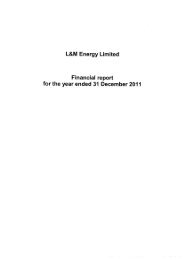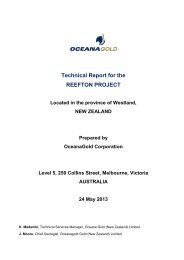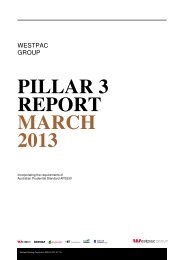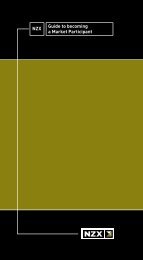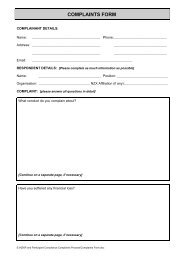NZSX/ NZDX Listing Rules APPENDIX 1 Part A (Rules 10.4.2 ... - NZX
NZSX/ NZDX Listing Rules APPENDIX 1 Part A (Rules 10.4.2 ... - NZX
NZSX/ NZDX Listing Rules APPENDIX 1 Part A (Rules 10.4.2 ... - NZX
Create successful ePaper yourself
Turn your PDF publications into a flip-book with our unique Google optimized e-Paper software.
THE 2004 AUSTRALASIAN CODE FOR REPORTING EXPLORATION RESULTS, MINERAL RESOURCES AND ORE RESERVES (THE JORC CODE)<br />
The Code provides for a direct two-way relationship<br />
between Indicated Mineral Resources and Probable<br />
Ore Reserves and between Measured Mineral<br />
Resources and Proved Ore Reserves. In other words,<br />
the level of geological confidence for Probable Ore<br />
Reserves is similar to that required for the<br />
determination of Indicated Mineral Resources, and<br />
the level of geological confidence for Proved Ore<br />
Reserves is similar to that required for the<br />
determination of Measured Mineral Resources.<br />
The Code also provides for a two-way relationship<br />
between Measured Mineral Resources and Probable<br />
Ore Reserves. This is to cover a situation where<br />
uncertainties associated with any of the Modifying<br />
Factors considered when converting Mineral<br />
Resources to Ore Reserves may result in there being<br />
a lower degree of confidence in the Ore Reserves<br />
than in the corresponding Mineral Resources. Such<br />
a conversion would not imply a reduction in the level<br />
of geological knowledge or confidence.<br />
A Probable Ore Reserve derived from a Measured<br />
Mineral Resource may be converted to a Proved Ore<br />
Reserve if the uncertainties in the Modifying Factors<br />
are removed. No amount of confidence in the<br />
Modifying Factors for conversion of a Mineral<br />
Resource to an Ore Reserve can override the upper<br />
level of confidence that exists in the Mineral<br />
Resource. Under no circumstances can an Indicated<br />
Mineral Resource be converted directly to a Proved<br />
Ore Reserve (see Figure 1).<br />
33.Public Reports of Ore Reserves must specify one or other<br />
or both of the categories of ‘Proved’ and ‘Probable’.<br />
Reports must not contain combined Proved and Probable<br />
Ore Reserve figures unless the relevant figures for each<br />
of the categories are also provided. Reports must not<br />
present metal or mineral content figures unless<br />
corresponding tonnage and grade figures are also given.<br />
Public Reporting of tonnage and grade outside the<br />
categories covered by the Code is not permitted unless<br />
the situation is covered by Clause 18, and then only in<br />
strict accordance with the requirements of that clause.<br />
Estimates of tonnage and grade outside of the<br />
categories covered by the Code may be useful for a<br />
company in its internal calculations and evaluation<br />
processes, but their inclusion in Public Reports could<br />
cause confusion.<br />
Ore Reserves may incorporate material (dilution)<br />
which is not part of the original Mineral Resource. It<br />
is essential that this fundamental difference between<br />
Mineral Resources and Ore Reserves is borne in mind<br />
and caution exercised if attempting to draw<br />
conclusions from a comparison of the two.<br />
When revised Ore Reserve and Mineral Resource<br />
statements are publicly reported they should be<br />
accompanied by reconciliation with previous<br />
statements. A detailed account of differences<br />
between the figures is not essential, but sufficient<br />
comment should be made to enable significant<br />
changes to be understood by the reader.<br />
Application of the category of Proved Ore Reserve<br />
implies the highest degree of confidence in the 34.In situations where figures for both Mineral Resources<br />
estimate, with consequent expectations in the minds and Ore Reserves are reported, a statement must be<br />
of the readers of the report. These expectations should included in the report which clearly indicates whether<br />
be borne in mind when categorising a Mineral the Mineral Resources are inclusive of, or additional to<br />
Resource as Measured.<br />
the Ore Reserves.<br />
Refer also to the guidelines in Clause 23 regarding<br />
classification of Mineral Resources.<br />
32.Ore Reserve estimates are not precise calculations.<br />
Reporting of tonnage and grade figures should reflect the<br />
relative uncertainty of the estimate by rounding off to<br />
appropriately significant figures. Refer also to Clause 24.<br />
To emphasise the imprecise nature of an Ore Reserve,<br />
the final result should always be referred to as an<br />
estimate not a calculation.<br />
Competent Persons are encouraged, where<br />
appropriate, to discuss the relative accuracy and/or<br />
confidence of the Ore Reserve estimates. The<br />
statement should specify whether it relates to global<br />
or local estimates, and, if local, state the relevant<br />
tonnage or volume. Where a statement of the relative<br />
accuracy and/or confidence is not possible, a<br />
qualitative discussion of the uncertainties should be<br />
provided (refer to Table 1).<br />
Ore Reserve estimates must not be aggregated with Mineral<br />
Resource estimates to report a single combined figure.<br />
In some situations there are reasons for reporting<br />
Mineral Resources inclusive of Ore Reserves and in<br />
other situations for reporting Mineral Resources<br />
additional to Ore Reserves. It must be made clear<br />
which form of reporting has been adopted.<br />
Appropriate forms of clarifying statements may be:<br />
‘The Measured and Indicated Mineral Resources are<br />
inclusive of those Mineral Resources modified to<br />
produce the Ore Reserves.’ or ‘The Measured and<br />
Indicated Mineral Resources are additional to the<br />
Ore Reserves.’<br />
In the former case, if any Measured and Indicated<br />
Mineral Resources have not been modified to<br />
produce Ore Reserves for economic or other reasons,<br />
the relevant details of these unmodified Mineral<br />
Resources should be included in the report. This is<br />
Note: Code is in normal typeface, guidelines are in indented italics, definitions are in bold.<br />
~ 11 ~



